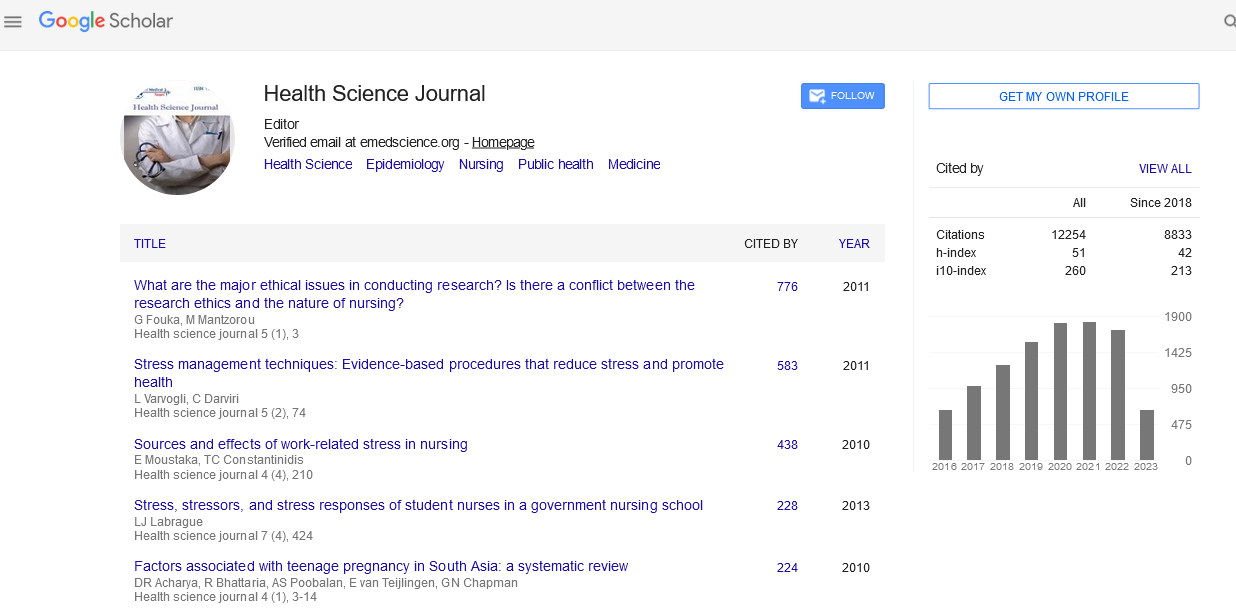Editorial - (2024) Volume 18, Issue 12
Impacts of Environmental Noise on Mental Health in Urban Settings
Sumire Kaneko*
Department of Health, University of Pennsylvania, USA
*Correspondence:
Sumire Kaneko, Department of Health, University of Pennsylvania,
USA,
Email:
Received: 01-Dec-2024, Manuscript No. Iphsj-24-15449;
Editor assigned: 04-Dec-2024, Pre QC No. Iphsj-24-15449 (PQ);
Reviewed: 26-Dec-2024, QC No. Iphsj-24-15449;
Revised: 28-Dec-2024, Manuscript No. Iphsj-24-15449 (R);
Published:
31-Dec-2024, DOI: 10.36648/1791-809X.18.12.1210
Abstract
Environmental noise, particularly in urban settings, has become a significant concern due to its potential adverse effects on public health. As urbanization continues to rise globally, exposure to environmental noise—originating from traffic, industrial activity, public spaces, and construction—has intensified. While physical health impacts of noise, such as hearing loss and cardiovascular issues, are widely recognized, the effects of noise on mental health have gained increasing attention. This article explores the psychological and emotional consequences of environmental noise in urban environments, examining how constant exposure can contribute to stress, anxiety, depression, cognitive decline, and sleep disturbances. The article also discusses the mechanisms behind these mental health impacts and suggests potential strategies for mitigating noise-related psychological harm in cities.
Introduction
Urban environments, characterized by dense populations [1], high traffic volumes, and constant human activity, are prone to elevated levels of environmental noise. As cities continue to expand, noise pollution becomes an inevitable consequence, raising concerns about its potential effects on public health. Noise is defined as unwanted or harmful sound, and its sources in urban settings are diverse, including road traffic, air traffic, industrial operations, construction work [2], and social activities. While much of the research on environmental noise has focused on its physical health implications, such as hearing loss, hypertension, and cardiovascular disease, there is growing recognition of the psychological and emotional toll it takes on individuals, especially in densely populated urban areas. Mental health issues related to environmental noise are becoming more evident as urbanization increases. The constant exposure to high noise levels can be stressful, contributing to a wide range of psychological disturbances. In particular, chronic exposure to noise is linked to heightened stress responses, disrupted sleep patterns, and an increased risk of mental health disorders such as anxiety and depression. As urban populations grow, understanding the relationship between environmental noise and mental health becomes crucial for public health initiatives aimed at improving the quality of life in cities [3].
Psychological Effects of Noise
One of the primary psychological impacts of environmental noise is its role in exacerbating stress. The constant bombardment of noise can trigger the body's stress response, activating the hypothalamic-pituitary-adrenal (HPA) axis, which leads to the release of stress hormones like cortisol. Chronic exposure to elevated cortisol levels can result in various mental health issues [4], including anxiety, depression, and irritability. Research has shown that individuals living in noisy urban environments often experience higher levels of psychological distress compared to those in quieter rural areas. This is particularly evident among vulnerable groups, such as children, the elderly, and individuals with pre-existing mental health conditions. In addition to stress, noise pollution has been linked to cognitive decline, particularly in children and the elderly. Studies have found that children living in noisy environments tend to perform poorly on tasks requiring attention, memory, and concentration. This may be due to the constant distractions caused by noise, which interfere with cognitive processing and learning. Similarly, older adults exposed to long-term noise may experience accelerated cognitive decline and a higher risk of dementia. The interruption of cognitive function due to chronic noise exposure can have a profound impact on overall quality of life and day-to-day functioning, contributing to a diminished sense of well-being [5].
Sleep Disturbances and Mental Health
Sleep disturbances are one of the most well-documented mental health effects of environmental noise. Noise, especially during the night, can disrupt sleep patterns, leading to both qualitative and quantitative sleep issues. The most common sleep disturbances caused by noise include difficulties falling asleep, frequent awakenings, and a reduction in deep sleep stages, which are essential for restorative rest [6]. Prolonged sleep deprivation has been associated with a range of mental health problems, including increased anxiety, depression, and heightened emotional sensitivity. The relationship between sleep and mental health is well-established, with poor sleep contributing to the onset and exacerbation of psychological disorders. Chronic sleep disturbances caused by noise can result in long-term mood disorders, irritability, and a general sense of mental exhaustion. Furthermore, the lack of restorative sleep impacts cognitive performance, leading to difficulties with concentration, memory, and decision-making. As urban noise levels continue to rise, the cumulative impact of disrupted sleep becomes an increasingly important issue for public health [7].
Anxiety Depression and Noise
The connection between environmental noise and mood disorders such as anxiety and depression is becoming more apparent in recent studies. Research has consistently shown that individuals living in areas with high noise levels are more likely to report symptoms of anxiety and depression compared to those in quieter environments. The constant exposure to noise pollution creates an environment of heightened arousal, making individuals more susceptible to stress and anxiety. Over time, the persistent stress caused by noise can lead to a sense of helplessness and emotional burnout, which are characteristic of depression. Noise-induced anxiety is often associated with the unpredictability and uncontrollability of noise. In urban environments, the sources of noise are often random and incessant [8], making it difficult for residents to escape or avoid exposure. This constant irritation can contribute to a chronic sense of unease, which may evolve into full-blown anxiety disorders. For some individuals, particularly those with a predisposition to mental health issues, the persistent stress from noise can act as a trigger, leading to the development or exacerbation of depression. The impact of noise on mental health is not only felt by those who are directly exposed but can also affect the broader social fabric of urban life. For example, residents of noisy areas may feel a greater sense of social disconnection or alienation. Noise can impair social interactions, reduce opportunities for community engagement, and increase the likelihood of conflicts between neighbors, further contributing to feelings of isolation and mental distress [9].
Mechanisms of Noise-Induced Mental Health Effects
The psychological effects of environmental noise can be understood through several biological and psychological mechanisms. As mentioned earlier, one of the primary pathways through which noise impacts mental health is the activation of the body's stress response system. When exposed to noise, the body perceives it as a stressor, which triggers a cascade of physiological responses, including the release of cortisol, adrenaline, and other stress hormones. Over time, chronic exposure to elevated levels of these hormones can contribute to the development of mental health issues such as anxiety, depression, and cognitive impairments [10]. Another mechanism involves the disruption of social behaviors and the sense of safety. Constant noise can alter an individual's perception of their environment, making it feel less secure and more chaotic. This can lead to a heightened sense of anxiety, particularly in urban settings where noise is often associated with dangerous or disruptive activities. Additionally, noise can interfere with communication and social bonding, reducing opportunities for meaningful social interactions, which are essential for mental well-being. Finally, sleep deprivation caused by noise acts as a mediator between noise exposure and mental health outcomes. Inadequate sleep not only directly impairs cognitive function and mood but also weakens the bodyâ??s ability to cope with stress. As sleep disturbances accumulate, the risk of developing more serious mental health conditions increases.
Mitigation Strategies and Policy Implications
Given the significant impact of environmental noise on mental health, mitigating noise pollution in urban areas is essential for improving public health outcomes. Various strategies can be implemented at both the individual and societal levels to reduce exposure to harmful noise. Urban planning measures, such as the creation of green spaces, noise barriers, and soundproof buildings, can help reduce the levels of environmental noise in cities. Zoning laws that limit noise from industrial and commercial sources and promote residential areas in quieter locations can also play a role in reducing noise pollution. On a personal level, individuals can take measures to mitigate noise exposure, such as using earplugs, installing soundproof windows, and creating quiet zones within their homes. Additionally, promoting healthy sleep hygiene, such as maintaining a consistent sleep schedule and reducing screen time before bed, can help alleviate the effects of sleep disturbances caused by noise. Finally, raising public awareness about the mental health impacts of noise and advocating for policies that prioritize noise reduction can lead to systemic changes that promote better mental health outcomes. Health professionals should also be trained to recognize the signs of noise-related mental health issues and integrate noise exposure assessments into routine health screenings.
Conclusion
The impact of environmental noise on mental health, particularly in urban settings, is a growing concern with significant public health implications. Chronic exposure to noise has been shown to contribute to a variety of mental health issues, including stress, anxiety, depression, and cognitive decline. The mechanisms behind these effects involve both biological responses to stress and psychological disruptions to sleep and social behaviors. Given the rapid pace of urbanization and the increasing prevalence of noise pollution, it is essential to address the mental health consequences of noise through effective urban planning, public health initiatives, and individual strategies to reduce exposure. By mitigating noise levels and promoting awareness, cities can foster healthier environments that support the mental well-being of their residents.
References
- Krishan K, Kanchan T, Thakur S A study of morphological variations of the human ear for its applications in personal identification.
Indexed at, Crossref
- Kyriakou G, Glentis A, Papanikolaou S (2021) Widow’s peak a usually overlooked, yet significant morphogenetic trait. JDDG J German Soc Derma 19: 1271-1275.
Indexed at, Google Scholar, Crossref
- Lane RD, Caruso AC, Brown VL, Axelrod B, Schwartz GE et al. (1994) Effects of non-right-handedness on risk for sudden death associated with coronary artery disease. American J Card 74: 743-747.
Indexed at, Google Scholar, Crossref
- Manning JT, Scutt D, Wilson J, Lewis-Jones DI (1998) the ratio of 2nd to 4th digit length: a predictor of sperm numbers and concentrations of testosterone, luteinizing hormone and oestrogen. Human Reproduction 13: 3000-3004.
Indexed at, Google Scholar, Crossref
- Mu L, Sanders I (2010) Human tongue neuro anatomy: Nerve supply and motor endplates. Clinical Anatomy 23: 777-791.
Google Scholar, Crossref
- Nissimov JN, das Chaudhuri AB (2014) Hair curvature a natural dialectic and review. Biological Reviews 89: 723-766.
Crossref
- Odokuma EI, Eghworo O, Avwioro G, Agbedia U (2008) Tongue Rolling and Tongue Folding Traits in an African Population. Int J Morphology 26: 533-535.
Google Scholar, Crossref
- Previc FH (1996) No right‐handedness, central nervous system and related pathology, and its lateralization: A reformulation and synthesis. Dev Neur 12: 443-515.
Indexed at, Google Scholar, Crossref
- James V, Corino G, Robertson T, Dutton N, Halas D et al. (2005) Early diagnosis of breast cancer by hair diffraction. Int J Cancer 114: 969-972.
Google Scholar, Crossref
- Kappert KDR, van Dijk S, Wellenstein D, van Alphe MJA, van Son RJJH et al. (2021) Five Specific Tongue Movements in a Healthy Population. Dysphagia, 36: 736-742.
Indexed at, Google Scholar, Crossref
Citation: Kaneko S (2024) Impacts of Environmental Noise on Mental Health in Urban Settings. Health Sci J. Vol. 18 No. 12: 1210.





